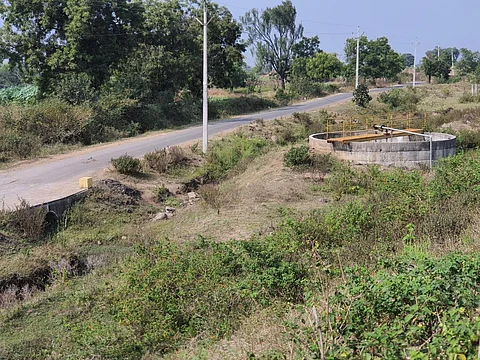

Kota Jahangir village in Maharashtra’s Jalna district was in the grip of an acute water shortage in the early 2000s. Women and children had to walk miles to fetch drinking water, recalled Bando Sarai, the sarpanch of the village.
The decreasing groundwater was also not very healthy for consumption due to high concentration of fluorides. “But we were forced to drink this water, as a result of which fluorosis became common.”
To tackle water scarcity, the Gram Panchayat formed a village water committee called paani samiti (water committee) in 2006. Women were motivated to participate and in a committee of 21, seven were women, said Fadat, the former sarpanch.
The samiti started bringing up issues such as getting tankers to supply water during lean periods and time lost by women folk in fetching water at the Gram Sabha meetings, said Datta Agade, chief of the committee.
A central source for water supply — a village pond — was identified. “Water is pumped and distributed through pipelines to 95 per cent of households,” said Bando.
The water is purified through a reverse osmosis filter before supplying to the houses to be used for drinking and farming. The household owners and the farmers pay a nominal annual fee of Rs 500, said Fadat.
The paani samiti chief said:
The committee meets once every month to monitor water supply and redress public grievances. Due to the ongoing pandemic, the frequency has been reduced to twice a year. The committee looks after water distribution systems, water quality monitoring, sustainability of water structures, agriculture along with operation and maintenance of distribution channels.
Around 40 farmers in the village have individual farm ponds while most of them are dependent on piped water supply, a member of the committee said.
There are almost 240 private wells and two-three government wells. “The village has also tried to make the groundwater source safe and sustainable. With the help of Watershed Organisation Trust, a Maharashtra based non-profit, the village has constructed many water harvesting structures using government schemes,” Bando added.
Bhokardan block, where the village is situated, has sandy clayey soil, which varies both in texture and depth, according to a district report by Central Groundwater Board. The soil has high porosity and low permeability.
Although the area receives an annual rainfall of 600-800 millimetres, the complex hydrogeology of the area causes water run-off. The dominating black cotton soil makes the groundwater recharge of the area difficult.
The strategic planning and designing of the water-harvesting structures have made recharge of the groundwater sustainable. The groundwater table has increased to 12-15 m from 18.5 m in the early 2000s, Bando noted.
The operation and maintenance of piped water is maintained through the funds of the Gram Panchayat. The technical issues are sorted through coordination of the block officers.
“Trained technical officials are there to help us fix technical glitches and make our source sustainable,” said Bajirao Patel, jal sevak of the village.
The officials also help the villages monitor water quality, so that every household receives safe water. “Preparing water health charts of the village and application of water budgeting tools helped villagers diagnose the water problem and take necessary actions to address the gap between water supply and demands,” Patel added.
Information, education and communication activities are regularly done to adopt sustainable practices like rain water harvesting, groundwater recharge by construction of soak pits, among others, said Kishan Shukraiche, a resident of the village. “Almost 90 per cent of the households now manage their wastewater either through soak pits or kitchen gardening.”
The committee also helps the villagers manage greywater. Fadat said:
Earlier, the wastewater mainly from kitchens and bathrooms used to flow in open stormwater drains. The wastewater from the storm drains used to enter the pond and contaminate the water. This led to breeding of mosquitoes and insects and spread of diseases like diarrhoea
Greywater from the bathroom and kitchen is safely managed and reused by households through construction of soak pits and kitchen gardens to produce fruits and vegetables, he added.
The wastewater passes through a small drain pipe into the soak pit or the kitchen garden constructed in low lying areas covered with filter media. The filter media usually comprises coarse gravel, boulders, pebbles and cobbles which reduces the amount of sulphates and organic load.
The soak pit is 1 m x 1m x 1.5m in size with concrete walls, covered with a slab. The greywater passes through the filter media and percolates in soil.
“The locally grown produce is consumed by the households and the excess is either exchanged with other households or sold in the local market,” said Swati Agade, a student from the village.
To prevent water logging during heavy downpour in the village in May-September, the samiti has constructed a percolation pond. Stormwater from drains and water overflow from the central pond moves towards this low-lying area.
Quality checks are done through field test kits provided under Jal Jeevan Mission to ensure sustainability and water quality, according to Patel. “Samples from both surface water sources and groundwater are also tested once every month in the district laboratory.”
Farmers are convinced to adopt sustainable agricultural practices to reduce water wastage by 60-70 per cent, prevent soil nutrient loss through ridge and furrow, poly-mulching technique as well as micro-irrigation systems like drip irrigation and sprinklers,” said Amrutaicche, gram rojgar sevak, Kota Jahangir village.
Cotton, chick pea, chilli, soybean, pepper, sorghum are the major agricultural crops grown by the farmers.